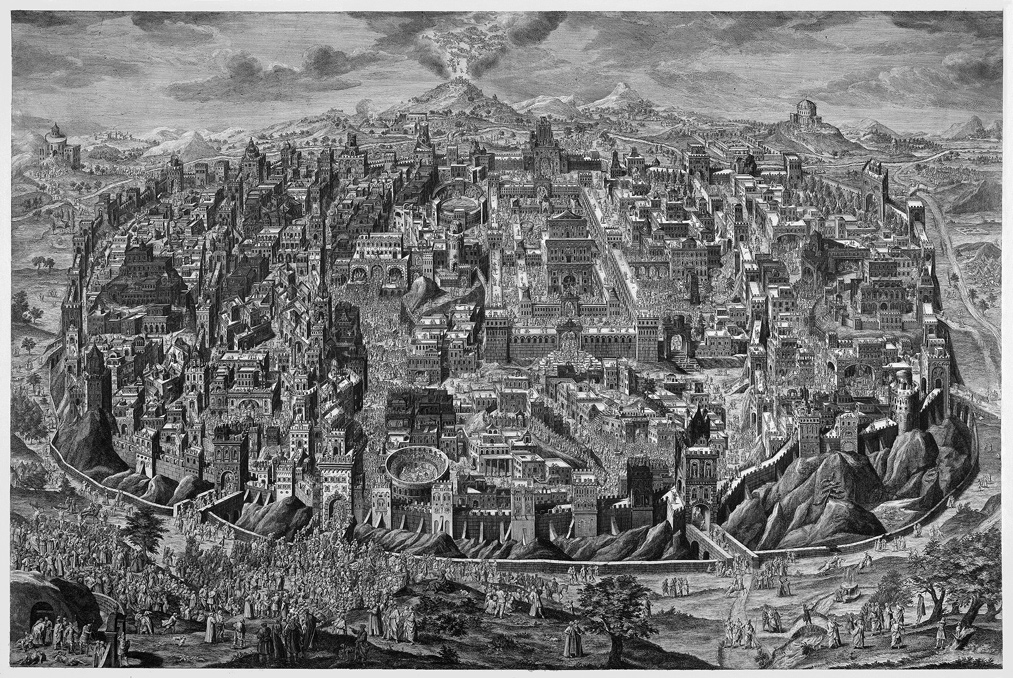Loading the page ...
Johann Daniel Herz
(1693–1754, Augsburg)
A Bird’s-eye View of the City of Jerusalem with Scenes from the Passion of Christ. Engraving from a plate. 82.6 x 123.5 cm (sheet size). Circa 1735. Not in Berliner Ornamentstichkatalog; Thieme-Becker, Allgemeines Lexikon, vol. XVI, p. 567; Nagler 2.
There is no complete list of the works in the extensive printed oeuvre of the Augsburg engraver and publisher, Johann Daniel Herz. The information provided by Nagler, for instance, is sparse. One probable explanation is that it is often very hard to distinguish between the artist’s own engravings and those he published. Herz was a very prolific engraver who participated in prominent large-scale projects such as Paul Decker’s monumental Architectura civilis (1711–16) and Johann Elias Ridinger’s New Equestrian Skills.
This highly impressive panorama of Jerusalem is extremely rare and moreover a technical tour de force, as it is an impression from a single copper plate, which indicates that the press must have been correspondingly large. In Augsburg, Herz had evidently specialized in the production of large-format prints, as a number of comparable engravings show, and our panorama is convincing proof of his skilful craftsmanship in this field. According to the inscription it is an invention by the artist himself. Herz offers the beholder a bird’s-eye view of the Holy City whose incredible sense of depth and wealth of detail are breathtaking. The city is surrounded by a high wall with battlements and picturesque towers. Inside these fortifications we can make out a fantastic urban microcosm of Eastern palaces, temples, amphitheatres and all sorts of other structures which are rendered in a careful and highly detailed engraving technique. Thousands of tiny figures populate the streets and squares of the city and occupy themselves in all sorts of ways. We see a gladiatorial combat, people out for a stroll or seeking diversion or engaging in everyday pursuits. The artist has cleverly inserted the individual scenes of the Passion story in this chaotic labyrinth, omitting not a single episode. This produces a curious effect, as the painstakingly depicted scenes seem almost lost against the overwhelming backdrop of architecture and massed humanity and take place simultaneously at various locations in the maze of city streets. The viewer is thus called upon to explore the huge panorama with the closest attention, an activity reminiscent of a game of hunt-the-thimble. Individual scenes portrayed in miniature form, such as the Last Supper, the Scourging or the Ecce Homo, show compositional and stylistic inspirations from Jacques Callot.
The Passion story begins at the top right, on the horizon, in the smallest format and almost casually, with the Entry of Christ into Jerusalem, while the dramatic culmination, the Crucifixion, is portrayed in the left foreground, at the opposite end of the city, and is only discernible after much peering. The portrayal of Jerusalem is known in two different versions. The other variant shows at the bottom a legend which corresponds to the tiny numbers in the portrayal and explains the individual scenes.
Magnificent, richly varied impression, trimmed to the borderline and remargined. A few minor defects, minor restorations along the sheet edges,otherwise – particularly in view of the size of the print – in excellent condition.
